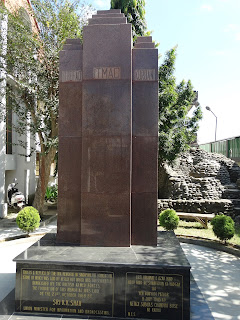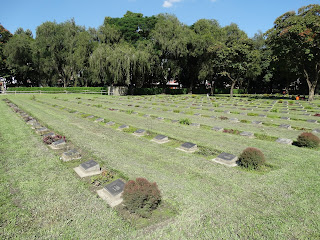After spending a better part of the morning at the Red Hill and India Peace Memorial, it was time to move on to my next destination Moirang. Moirang is situated 45 kilometres from Imphal and about 30 km's from the India Peace Memorial. The journey from the Red Hill crosses the beautiful Loktak Lake on the right and a wooded range of hills that flirt with the winding road sometimes in close proximity and sometimes a few miles away.
We reached the town of Moirang where the INA Museum is located. Moirang has a historical significance as the INA headquarters during the Battle for Imphal were located in this town. Colonel Shaukat Malik of INA raised the Indian tri-colour for the first time on April 14th, 1944 a red letter day in the Indian freedom struggle, which is sadly omitted from our history books. (see images below - INA Museum Moirang, photos - courtesy author)
Entrance to INA Museum, Moirang
While entering through the gates of the INA Museum, there stands a statue of the iconic leader Subhas Chandra Bose, the leader of INA. Standing to take a few photos, i noticed the INA's Martyr's Memorial on the extreme right and the Museum building on the left. Tracing my steps to enter the Museum i discovered that no photography is allowed inside the museum ! This limited my photos to the outer periphery, Netaji's statue and the Martyr's memorial.
A historic moment for me as i stood before the statue of INA's leader Netaji
Stepping inside the museum, one finds two sections where one is devoted to rare photos of INA in action during the war and of Netaji in different events in different places like India, Germany, Japan. There are a few colour photos as well of the iconic leader but sadly these are in a state of decay and in need for urgent preservation and restoration. It is explicable to me as to why such a treasure trove of rare photos and information is kept away from the photo enthusiasts as it help spreads the message (including maps of INA's march forward in 1944 and subsequent retreat in late 1944 early 1945).
The other section is devoted to equipment used by INA including guns, shells, coins and insignia. There is a separate gallery where the freedom fighters from Manipur and Chief Ministers are listed with photos. After spending an hour at the museum i finally stepped out with a heavy heart, that i had seen so much and yet there was little i could take in the form of photos to spread awareness about how much we need to visit Imphal and its nearby areas to truly comprehend the history of our freedom struggle.
My final stop at the Museum was the INA Martyr's Memorial. For the uninitiated this is a replica of INA Memorial setup in Singapore in July 1945 in memory of the INA men and women who lost their lives. The original memorial at Esplanade Park, Singapore was destroyed by the British when they recaptured Singapore in August 1945. The replica memorial was setup in 1968 and inaugurated by Prime Minister Indira Gandhi in 1969. (see images below)
The memorial has the 3 words that tell us the DNA and character of the INA - Ittefaq, Itmad and Qurbani. As i walked away finally that afternoon i knew every moment of this trip had been worth it. I went with an open mind to Manipur not knowing what to expect and i came back overawed by the amount of history it has. It is our duty to ensure that we respect our history and protect our heritage before it is lost to future generations.
Before returning to Imphal, me made a final stop at the picturesque Loktak Lake. I had seen it from the air when the flight landed at Imphal. Getting to see the serene beauty of the lake from an adjacent hilltop, made my trip worthwhile.
The beautiful colours of Loktak Lake
Road to Imphal from hill top with Loktak Lake
If you are planning a trip to North East add Manipur to your list. Do keep a lookout for the law and order situation that sometimes does get delicate though. Happy travels !!
We reached the town of Moirang where the INA Museum is located. Moirang has a historical significance as the INA headquarters during the Battle for Imphal were located in this town. Colonel Shaukat Malik of INA raised the Indian tri-colour for the first time on April 14th, 1944 a red letter day in the Indian freedom struggle, which is sadly omitted from our history books. (see images below - INA Museum Moirang, photos - courtesy author)
A Truly Historic Moment captured in a stone plaque
Entrance to INA Museum, Moirang
While entering through the gates of the INA Museum, there stands a statue of the iconic leader Subhas Chandra Bose, the leader of INA. Standing to take a few photos, i noticed the INA's Martyr's Memorial on the extreme right and the Museum building on the left. Tracing my steps to enter the Museum i discovered that no photography is allowed inside the museum ! This limited my photos to the outer periphery, Netaji's statue and the Martyr's memorial.
A historic moment for me as i stood before the statue of INA's leader Netaji
Stepping inside the museum, one finds two sections where one is devoted to rare photos of INA in action during the war and of Netaji in different events in different places like India, Germany, Japan. There are a few colour photos as well of the iconic leader but sadly these are in a state of decay and in need for urgent preservation and restoration. It is explicable to me as to why such a treasure trove of rare photos and information is kept away from the photo enthusiasts as it help spreads the message (including maps of INA's march forward in 1944 and subsequent retreat in late 1944 early 1945).
The other section is devoted to equipment used by INA including guns, shells, coins and insignia. There is a separate gallery where the freedom fighters from Manipur and Chief Ministers are listed with photos. After spending an hour at the museum i finally stepped out with a heavy heart, that i had seen so much and yet there was little i could take in the form of photos to spread awareness about how much we need to visit Imphal and its nearby areas to truly comprehend the history of our freedom struggle.
My final stop at the Museum was the INA Martyr's Memorial. For the uninitiated this is a replica of INA Memorial setup in Singapore in July 1945 in memory of the INA men and women who lost their lives. The original memorial at Esplanade Park, Singapore was destroyed by the British when they recaptured Singapore in August 1945. The replica memorial was setup in 1968 and inaugurated by Prime Minister Indira Gandhi in 1969. (see images below)
The memorial has the 3 words that tell us the DNA and character of the INA - Ittefaq, Itmad and Qurbani. As i walked away finally that afternoon i knew every moment of this trip had been worth it. I went with an open mind to Manipur not knowing what to expect and i came back overawed by the amount of history it has. It is our duty to ensure that we respect our history and protect our heritage before it is lost to future generations.
Before returning to Imphal, me made a final stop at the picturesque Loktak Lake. I had seen it from the air when the flight landed at Imphal. Getting to see the serene beauty of the lake from an adjacent hilltop, made my trip worthwhile.
The beautiful colours of Loktak Lake
Road to Imphal from hill top with Loktak Lake
If you are planning a trip to North East add Manipur to your list. Do keep a lookout for the law and order situation that sometimes does get delicate though. Happy travels !!




































































